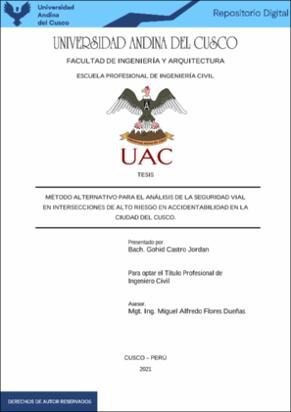| dc.contributor.advisor | Flores Dueñas, Miguel Alfredo | |
| dc.contributor.author | Castro Jordan, Gohid | |
| dc.date.accessioned | 2021-09-06T17:33:09Z | |
| dc.date.available | 2021-09-06T17:33:09Z | |
| dc.date.issued | 2021-04-23 | |
| dc.identifier.uri | https://hdl.handle.net/20.500.12557/4083 | |
| dc.description.abstract | A partir del año 2013, la ciudad del cusco presenta un incremento de accidentes de tránsito
en la red vial urbana, debido al incremento del parque automotor, deficiencias en el diseño
geométrico, deterioro y falta de mantenimiento de la vía. Debido a esta problemática es
necesario determinar una herramienta de seguridad vial y su correcta implementación en el
ámbito urbano. Esta investigación está enfocada en el análisis de la seguridad vial en
intersecciones de alto riesgo en accidentabilidad en la ciudad del Cusco, aplicando una
metodología alternativa que es la combinación del análisis de conflictos entre vehículos y el
método de análisis de componentes principales.
El objetivo de la tesis es establecer un método alternativo que permita cuantificar la
accidentalidad de una intersección mediante la obtención de una variable respuesta que es el
índice de riesgo.
El desarrollo experimental se realizó mediante estudios de campo, donde se seleccionaron
por conveniencia 6 intersecciones urbanas en forma de T y Cruz (+) donde se obtuvieron las
variables que caracterizan los conflictos entre vehículos, los cuales son: distancia de frenado,
velocidad de aceleración, tiempo hasta la colisión, tiempo posterior a la invasión y tiempo
de evasión.
Se concluyó que los valores altos en el índice de riesgo representan mayor riesgo de que un
conflicto termine en accidente, por lo que el rol de signos en cada variable es relevante.
Dentro de este índice se tiene a la variable velocidad de aceleración con signo negativo, lo
que demuestra una situación real de un conflicto, pues a mayor velocidad, es mayor la
probabilidad de que exista una colisión en el conflicto estudiado. Los índices de riesgo
obtenidos se encuentran entre el intervalo de 40.94 y 63.91, estos representan riesgos
medianos de accidentalidad en las intersecciones estudiadas; además se ha determinado que
las 2 intersecciones semaforizadas son menos riesgosas en comparación a las 4
intersecciones no semaforizadas, debido a que generalmente una intersección no
semaforizada presenta menor volumen de vehículos que una intersección semaforizada.
Finalmente, es necesario mencionar que la metodología presentada en la investigación no es
muy conocida en el Perú, por tanto, debería ser implementada para el análisis de la seguridad
vial en áreas urbanas por las autoridades competentes. | es_PE |
| dc.description.abstract | After 2013 Cusco city presents an increase of the traffic accidents in the urban vial network,
due to the increment of the automotive stock, deficiencies in the geometric design,
deterioration, and lack of maintenance of the network. A tool for the vial security of
necessary to address this problem by implementing it in the urban sector. This study focus
in the analysis of the vial security of high risk intersections in Cusco city applying an
alternative methodology which is a combination of conflict analysis and principal
component analysis
This thesis aims at establishing an alternative method which permit to quantify the accident
rate of an intersections by obtaining a response variable, the risk index. The experimental
development was made through field studies, by convenience urban intersections with T and
cross (+) shape were selected for the characterization of the conflicts. The variables selected
were the braking distance, velocity of acceleration, time to collision, time posterior to
invasion and time of evasion.
It was concluded that high values of the risk index represent a higher risk that a conflict
becomes an accident, thus the role of the sign in each variable is relevant. Velocity of
acceleration has a negative sign in the risk index formula, since higher is the velocity, higher
the probability that exist a collision in the studies conflict. The risk index obtained is between
10.94 and 63.91, these represent medium risk of accident in the two instrumented
intersections. In addition, it was determined that the risk of these two intersections is smaller
than the risk of the other four intersections. This is due to the fact that non-instrumented
shows a smaller volume of traffic that instrumented intersections.
Finally, it should be said that the methodology presented in this study has not been employed
previously in Peru. Then, further research should be implemented by authorities in urban
areas. | en_US |
| dc.format | application/pdf | es_PE |
| dc.language.iso | spa | es_PE |
| dc.publisher | Universidad Andina del Cusco | es_PE |
| dc.rights | info:eu-repo/semantics/openAccess | es_PE |
| dc.rights.uri | https://creativecommons.org/licenses/by-nc-nd/4.0/ | es_PE |
| dc.subject | Accidentalidad | es_PE |
| dc.subject | Seguridad vial | es_PE |
| dc.subject | Índice de riesgo | es_PE |
| dc.title | Método alternativo para el análisis de la seguridad vial en intersecciones de alto riesgo en accidentabilidad en la ciudad del Cusco | es_PE |
| dc.type | info:eu-repo/semantics/bachelorThesis | es_PE |
| thesis.degree.name | Ingeniero Civil | es_PE |
| thesis.degree.grantor | Universidad Andina del Cusco. Facultad de Ingeniería y Arquitectura | es_PE |
| thesis.degree.discipline | Ingeniería Civil | es_PE |
| dc.publisher.country | PE | es_PE |
| dc.subject.ocde | https://purl.org/pe-repo/ocde/ford#2.01.00 | es_PE |
| renati.advisor.dni | 23950763 | |
| renati.author.dni | 70310648 | |
| renati.discipline | 732016 | es_PE |
| renati.juror | Zevallos Guzman, Herbert Jesus | |
| renati.juror | Alvarez Monterola, Walter Roberto | |
| renati.juror | Perez Montesinos, Jean Fernando | |
| renati.juror | Chipana Molina, Yimmy Johan | |
| renati.level | https://purl.org/pe-repo/renati/level#tituloProfesional | es_PE |
| renati.type | https://purl.org/pe-repo/renati/type#tesis | es_PE |


